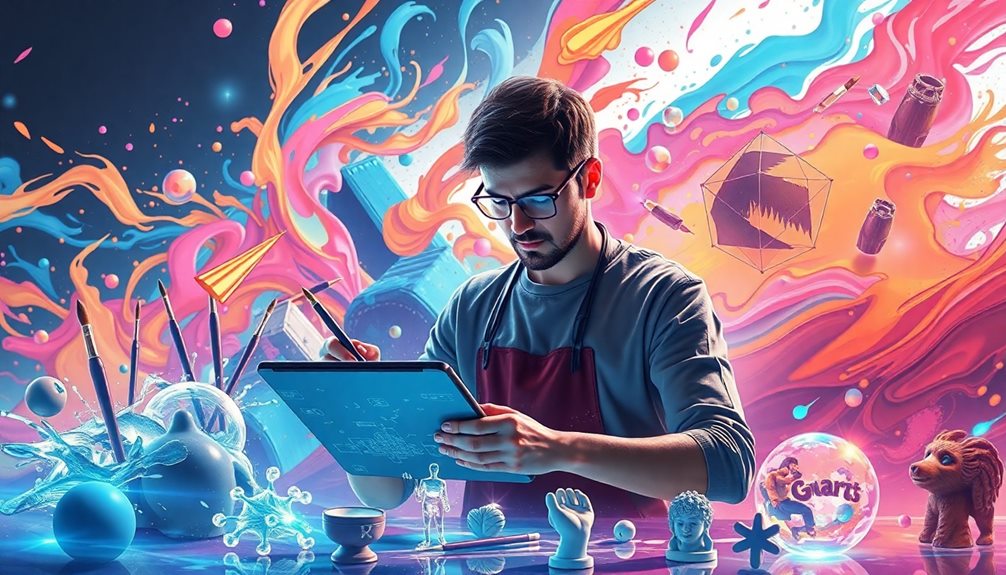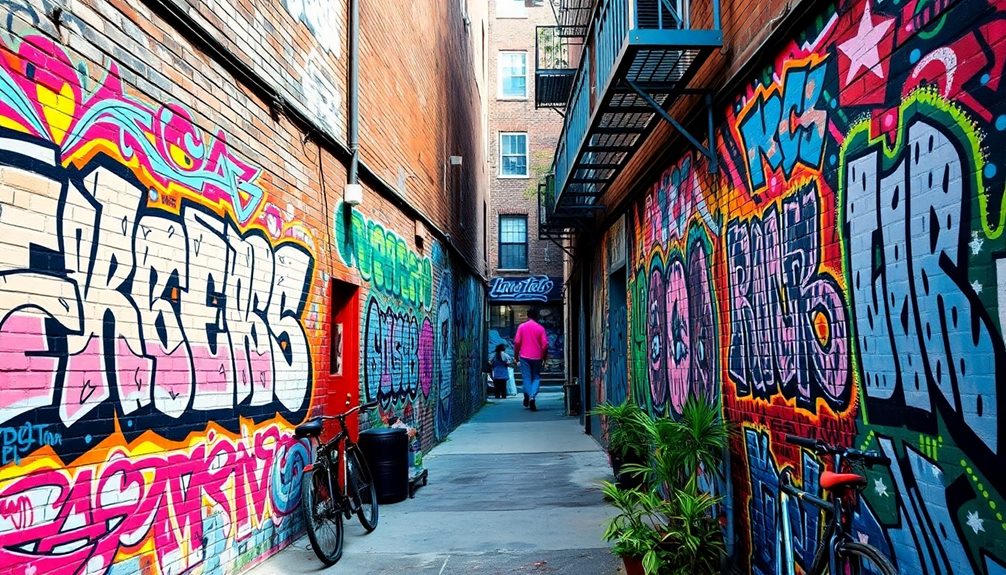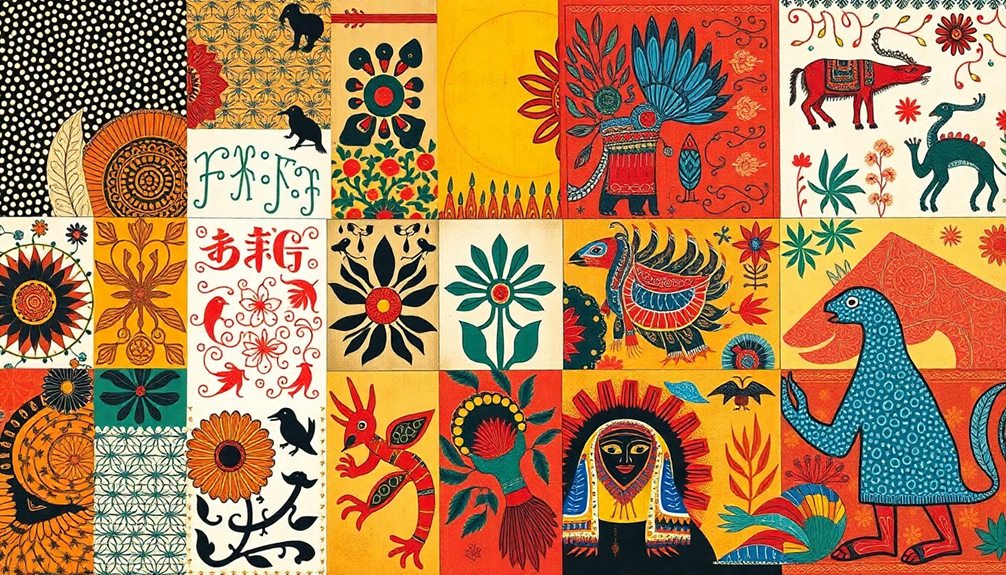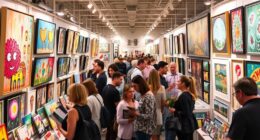Technology's impact on art creation has transformed how you express and experience creativity. With digital tools like Adobe Photoshop and innovative techniques in VR and AR, you can explore new artistic possibilities that were once unimaginable. These advancements not only enhance your creative process but also allow you to connect with a global audience. Immersive installations engage you in multi-sensory storytelling, enriching your understanding of art. However, challenges like the digital divide and questions about emotional depth also arise. If you're curious about how these trends shape the future of artistic expression, there's more to discover.
Key Takeaways
- The digital revolution and tools like Adobe Photoshop have expanded creative possibilities, enabling artists to experiment and iterate quickly.
- Emerging technologies such as VR and AR create immersive experiences, transforming traditional art engagement into participatory and interactive storytelling.
- Digital platforms democratize access to art, allowing artists to reach global audiences and showcase their work without geographic limitations.
- AI technology enhances creativity and storytelling, while collaborative tools facilitate real-time sharing and remote art creation among artists.
- While technology offers new opportunities, challenges like the digital divide and commercialization pressures can impact artistic authenticity and traditional skills.
Historical Context of Art and Technology
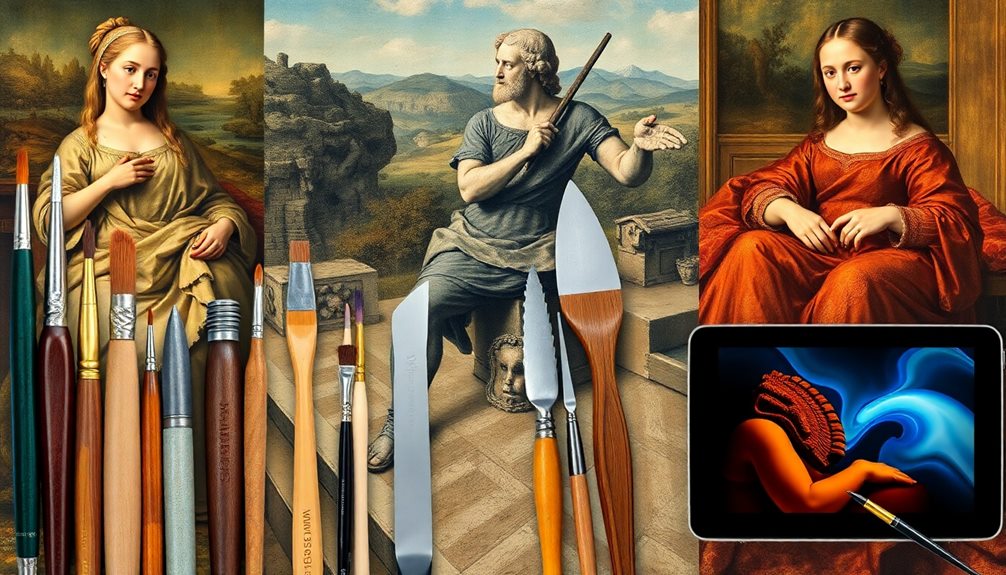
How has technology shaped the evolution of art throughout history? You'll find that the relationship between art and technology is deeply intertwined.
For instance, the introduction of oil paint during the Renaissance revolutionized artistic expression, allowing for greater depth and realism that traditional art forms couldn't achieve. This advancement opened new doors for creativity, enabling artists to explore their ideas more vividly.
Fast forward to the 19th century, when the invention of photography transformed visual representation. Artists began to experiment with capturing reality in innovative ways, paving the path for movements like Impressionism. Each technological leap has pushed the boundaries of what art can be.
In the 1980s, the digital revolution introduced tools like Adobe Photoshop and Illustrator, fundamentally changing artistic processes. This shift not only impacted how art is created but also how it's shared.
Online platforms have democratized access, allowing artists from diverse backgrounds to showcase their work globally.
Today, emerging technologies like virtual reality and augmented reality are further expanding the landscape of artistic expression, inviting viewers into immersive experiences that redefine traditional galleries.
Technology continues to shape the evolution of art, pushing its limits and possibilities.
New Artistic Mediums and Techniques
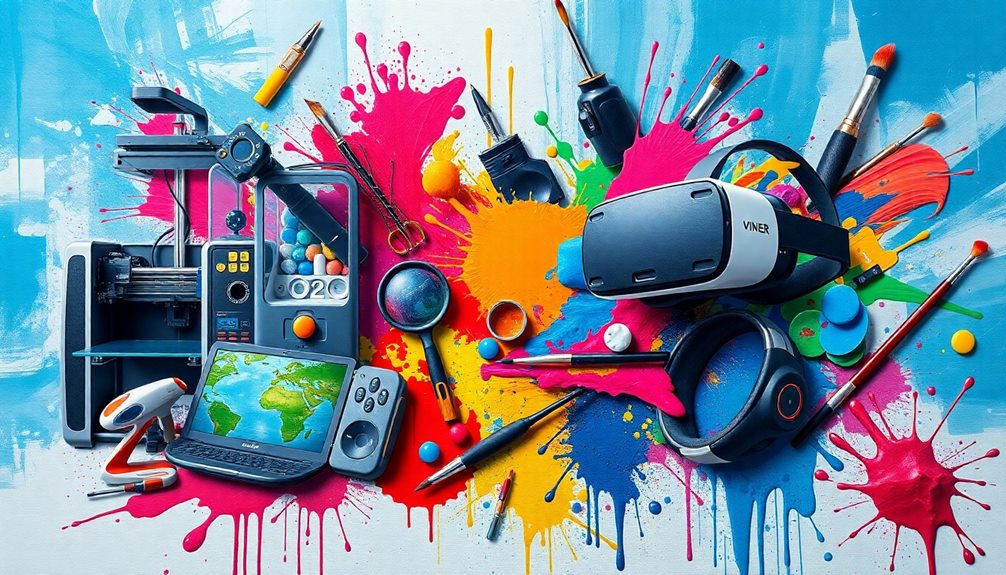
You've likely noticed how digital painting innovations are transforming the art world, offering unique ways to express creativity.
With interactive art experiences becoming more prevalent, you can engage with pieces in ways that traditional mediums simply can't match.
Let's explore how these advancements are reshaping artistic expression today.
Digital Painting Innovations
Digital painting innovations have transformed the art world, offering artists unprecedented tools and techniques that enhance their creative expression. With graphic design software and tablets at your fingertips, the creative process becomes an exhilarating journey. You can explore new mediums and styles like never before.
Consider these exciting aspects of digital painting:
- Endless Experimentation: You can try countless colors, textures, and effects without the fear of wasting materials.
- Rapid Iterations: Programs like Adobe Photoshop and Procreate allow you to make quick adjustments, perfecting your artwork in real-time.
- Global Reach: Share your digital art online, connecting with a diverse audience and opening up collaboration opportunities.
These innovations have birthed new forms of art, such as concept art for video games and films, pushing the boundaries of creativity.
As you immerse yourself in digital painting, you're not just creating art; you're engaging in a limitless exploration of your imagination. Embrace these advancements and let them inspire your unique artistic voice!
Interactive Art Experiences
Transforming the way you experience art, interactive art experiences invite you to step into immersive environments that actively engage your senses. By leveraging technology like virtual reality (VR) and augmented reality (AR), these experiences allow you to participate in and influence the artwork, turning passive observation into active involvement.
Here's a glimpse of what you might encounter in interactive art:
| Experience Type | Technology Used | Audience Engagement |
|---|---|---|
| Virtual Reality Art | VR headsets | Full immersion in a digital landscape |
| Augmented Reality Art | Mobile devices | Interaction with digital elements in real-world settings |
| Generative Art | Algorithms and code | Unique artwork based on your inputs |
| Multimedia Installations | Sound and video | Emotional connections through sensory stimuli |
Many contemporary artists explore generative art, where algorithms and user interactions create evolving pieces. This innovative approach challenges conventional ideas of authorship. The rise of interactive art has broadened audience diversity, making art more accessible and resonant through unique storytelling methods. Embrace the future of art and see how digital tools transform your engagement!
Immersive Experiences With VR and AR
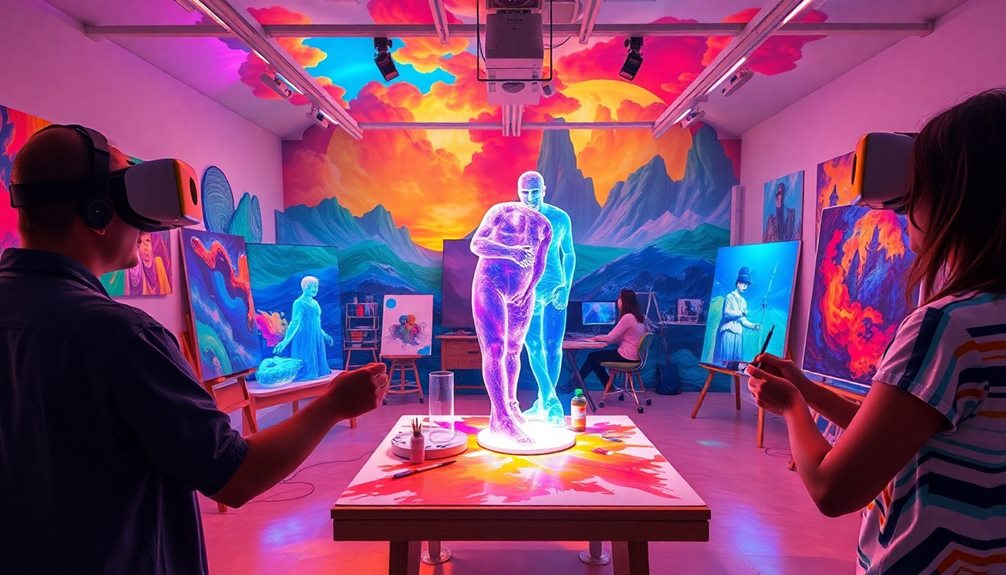
When you step into a VR or AR art installation, you're not just looking at artwork; you're becoming part of the experience.
These technologies enhance audience engagement by allowing you to interact with the art in real-time, crafting a unique, multi-sensory storytelling adventure.
As you explore these immersive environments, you'll discover how they transform traditional art into something dynamic and participatory.
Enhanced Audience Engagement
Immersive experiences with virtual reality (VR) and augmented reality (AR) have revolutionized how you engage with art. These digital technologies transform passive viewing into dynamic interactions, allowing you to step inside the artwork and become part of the narrative. This shift enhances emotional and sensory engagement, making every visit memorable.
Consider how immersive experiences can:
- Deepen your understanding of the artist's message by actively involving you in the themes.
- Encourage empathy, as you personally navigate the stories told through the art.
- Extend access to art, letting you explore high-quality pieces from anywhere, regardless of your background.
With VR, you can wander through virtual galleries, while AR overlays digital content onto physical pieces, enriching your experience.
As a result, artists have seen increased audience retention and engagement, with visitors spending more time immersed in the art. The rise of these technologies not only broadens audience engagement but also fosters a deeper connection to the artwork.
Interactive Art Installations
In recent years, interactive art installations have redefined how you experience creativity, inviting you to step beyond the role of a passive observer. With the integration of Virtual Reality (VR) and Augmented Reality (AR), these immersive environments engage you as an active participant in the artwork. You're no longer just watching; you're interacting, exploring, and influencing the art around you.
Artists harness VR and AR technologies to create multi-sensory experiences, blending sound, motion, and visual effects that enhance storytelling and emotional connections. Imagine stepping into a digital gallery where you can interact with artworks in real-world settings, breaking geographical barriers and expanding access to art experiences.
Notable examples, like TeamLab's "Borderless" exhibit in Tokyo, showcase how such installations foster audience engagement. Here, the dynamic, ever-changing nature of the artwork encourages exploration and interaction, leading to deeper emotional responses.
Studies show that these immersive experiences not only increase engagement but also help you retain the artwork's message longer. In this new era of interactive art installations, your active participation transforms the way you connect with creativity, making each visit a unique journey.
Multi-Sensory Storytelling Experiences
Through the lens of technology, multi-sensory storytelling experiences are revolutionizing how you engage with narratives. Virtual reality (VR) and augmented reality (AR) enable you to step into immersive experiences, transforming storytelling into something profoundly interactive. You're no longer just a spectator; you become part of the art.
Consider these emotional impacts of multi-sensory storytelling:
- Heightened Connection: Studies show that immersive storytelling can increase your emotional engagement by 60%. You feel the story.
- Interactive Exploration: With AR, you can overlay digital elements onto your surroundings, making the experience personal and unique.
- Empowered Expression: Artists like Marina Abramović invite you to participate, pushing the boundaries of traditional narratives.
As technology is changing the landscape of art, you'll find that these immersive experiences allow you to explore narratives at your own pace, engaging all your senses.
You're not just consuming art; you're living it. The possibilities are endless, and the stories are waiting for you to immerse yourself. Embrace these multi-sensory encounters and discover how they can deepen your appreciation for art and storytelling.
The Creative Process in the Digital Age
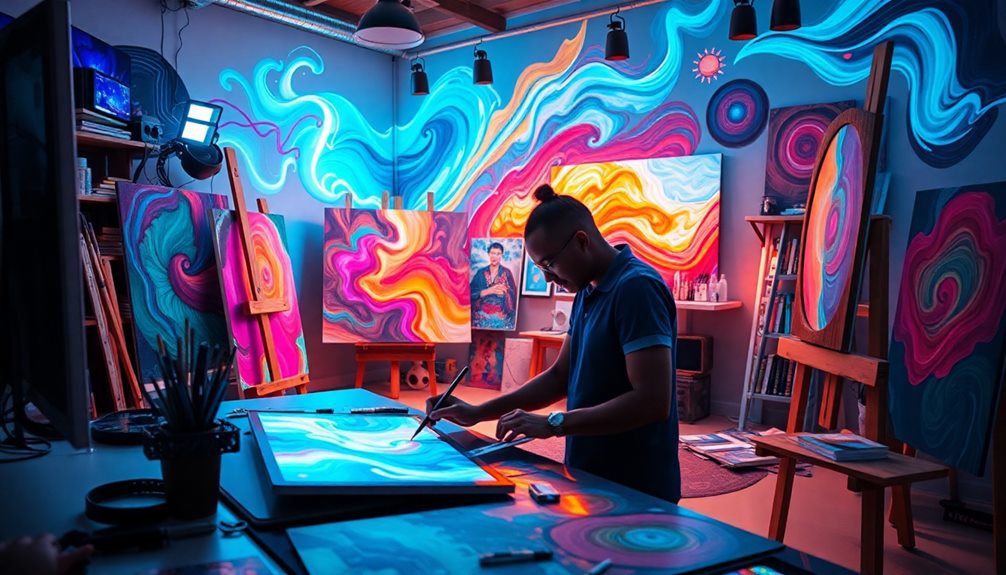
The digital revolution has transformed the creative process, providing artists with a toolbox of unprecedented resources. With software like Adobe Photoshop and Illustrator now industry standards, you can explore new forms of art that were once unimaginable. These tools allow you to experiment with endless variations and make intricate edits, considerably enhancing your creative process compared to traditional methods.
In addition, advancements in AI technology are enabling artists to harness generative AI in media, fostering innovative storytelling and creativity. Digital sketching tools offer instant feedback, letting you easily revise your creations and streamline the iterative process of artistic development. As technology continues to evolve, artists are increasingly embracing generative art, where algorithms create unique and evolving artworks, pushing the boundaries of creativity. This innovative approach not only broadens your artistic horizons but also encourages you to think differently about your work.
Moreover, collaborative tools enable you to work remotely, facilitating real-time idea sharing and fostering a sense of community among creators, no matter where you are. This interconnectedness enhances the overall artistic experience, making it more engaging and dynamic.
In the digital age, the creative process isn't just about individual expression; it's about collaboration and exploration in a constantly shifting landscape of possibilities.
Accessibility and Global Reach
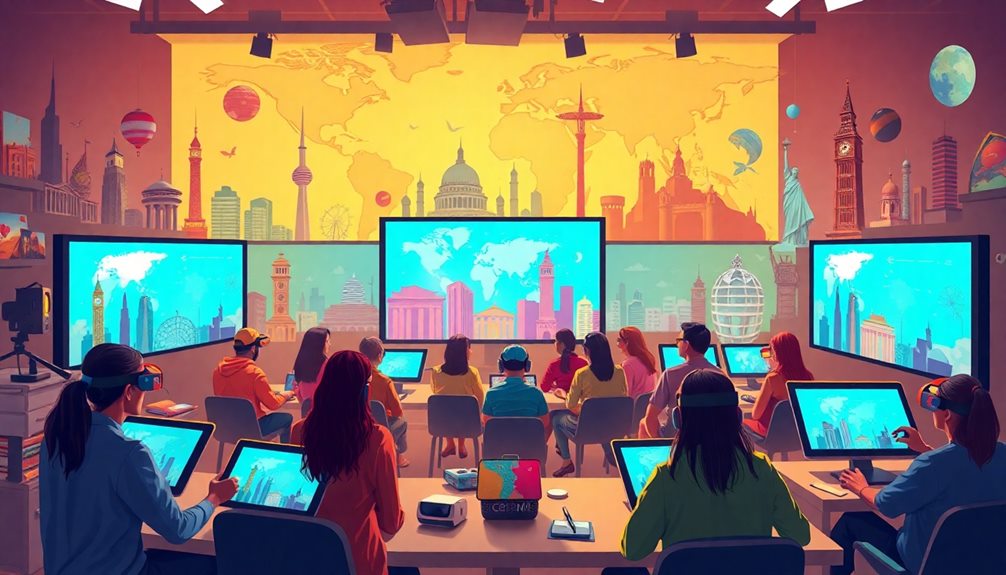
Technology has opened up incredible opportunities for artists, allowing you to share your work with a global audience in mere seconds. In this digital age, accessibility has transformed the way you connect with art lovers around the world. Online platforms like social media and digital galleries empower you to showcase your talent without the limitations of physical spaces.
Here are three ways technology enhances your reach as an artist:
- Global Exposure: You can instantly share your creations with people from diverse backgrounds, breaking geographical barriers.
- Detail Appreciation: High-resolution viewing capabilities let audiences appreciate intricate details in your artwork that traditional formats often miss.
- Direct Support: Crowdfunding and social media enable you to gain support and feedback directly from your audience, fostering innovative projects.
This democratization of the art world means that you no longer need to fit a certain mold to be noticed. Instead, you can thrive in a vibrant ecosystem where your art can find its place, resonate with viewers, and inspire collaborations—no matter where you're in the world.
Embrace these opportunities and let your creativity shine!
Challenges and Critiques of Digital Art
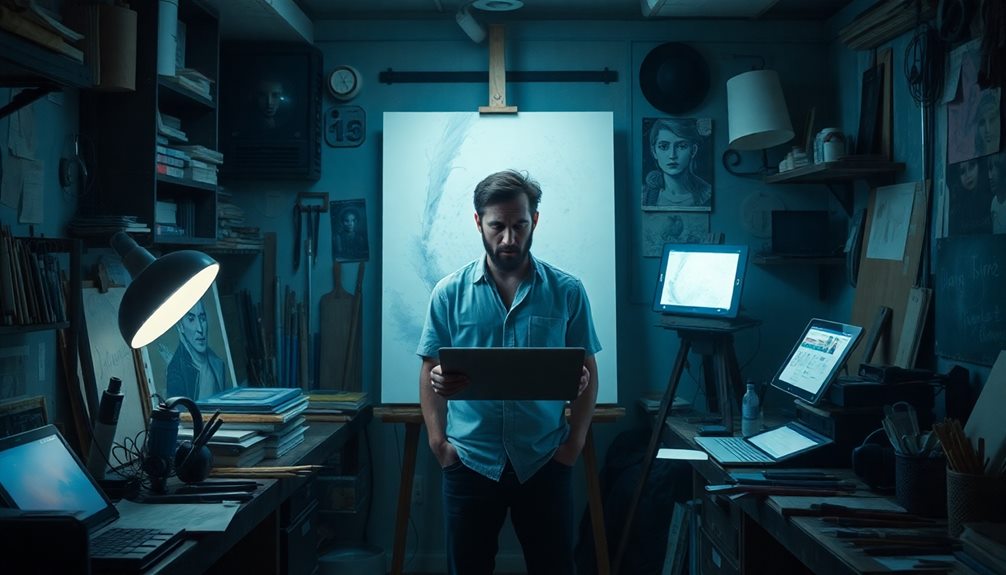
While digital art offers remarkable opportunities, it also brings a host of challenges that artists must maneuver. One significant issue is the digital divide, which highlights the disparities in access to technology. If you lack the necessary tools and resources, it can hinder your ability to create and share your work effectively.
Additionally, copyright issues are prevalent in the digital domain, complicating ownership and distribution. You might find it difficult to protect your creations amidst the vast landscape of digital content.
Critics also question the emotional depth of AI-generated art, arguing that machine-produced works often lack the true creativity that comes from human experience. This concern raises doubts about what constitutes genuine artistic expression.
Furthermore, the commercialization of digital art can compromise artistic integrity. With the pressures of marketability and audience preferences, you may feel forced to conform rather than express your unique vision.
Lastly, an over-reliance on technology could diminish traditional skills and techniques, threatening the future of craftsmanship in the arts. Balancing these challenges with the benefits of digital tools is essential for you as an artist maneuvering this evolving landscape.
Future Trends in Art and Technology
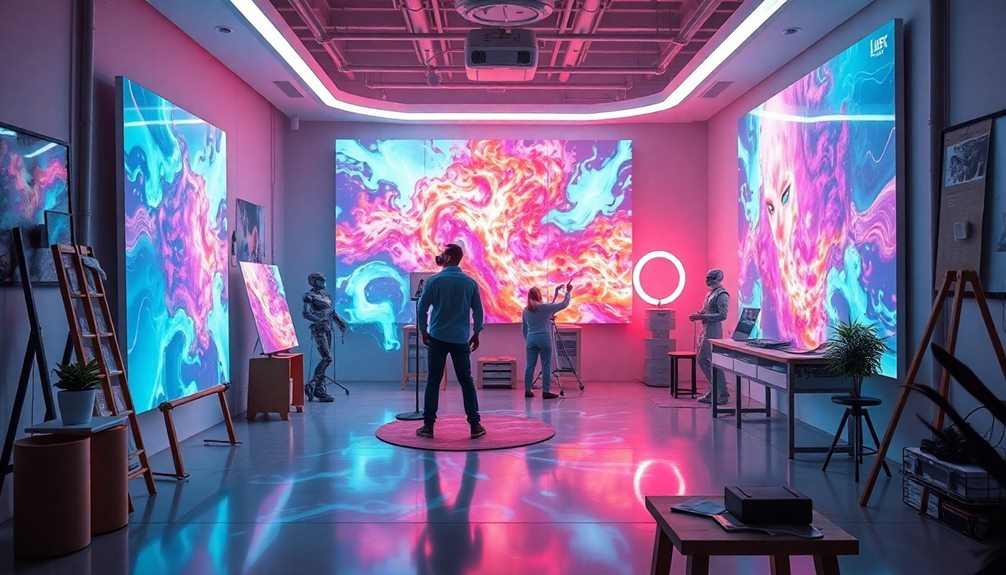
As you navigate the challenges posed by digital art, exciting developments are on the horizon that promise to reshape the artistic landscape. The future is filled with new possibilities that you'll want to explore.
Here are three transformative trends to look out for:
- Virtual and Augmented Reality: These technologies will redefine how you experience and engage with art, immersing you in multi-sensory environments that blur the line between creator and audience.
- Artificial Intelligence Collaboration: Expect the emergence of new collaborative platforms, allowing you to work alongside AI, leading to innovative artistic creations and redefining ownership models for AI-generated works.
- Generative Art: As algorithms create unique and evolving artworks, you'll find yourself challenged by new definitions of authorship and creativity.
Additionally, the integration of NFTs is revolutionizing the way artists sell and own digital art, opening up new revenue streams and transforming traditional ownership models.
With these trends, the art world is on the brink of significant transformation, inviting you to embrace the changes and enhance your creative journey.
Frequently Asked Questions
How Has Technology Influenced the Creation of Art?
You'll find that technology influences art creation by offering new tools and mediums, enabling precision and experimentation. It opens up global platforms for sharing, allowing you to connect with audiences and fellow artists like never before.
What Are the Advantages of Using Technology in Creating Art?
Using technology in creating art gives you precision, expands your creative possibilities, and allows for instant feedback. You can experiment freely, streamline repetitive tasks, and connect with a global audience, enhancing your artistic journey.
How Does Technology Help Artist With Their Art?
Did you know 80% of artists say digital tools enhance their creativity? With advanced software, you can explore new techniques, receive instant feedback, and connect globally, transforming your artistic journey into an innovative, collaborative experience.
How Has Technology Made Art More Accessible?
Technology's made art more accessible by breaking down barriers. You can easily find online tutorials, showcase your work on social media, and connect with global audiences, making it simpler than ever to share your creativity.
Conclusion
As you explore the intersection of technology and art, you might just stumble upon an unexpected masterpiece created with a simple app. This fusion not only enhances creativity but also connects you with artists worldwide. While challenges and critiques linger, the excitement of innovative mediums and immersive experiences keeps the art world vibrant. Embrace the future, and who knows? You could be the one to redefine art in this digital age, creating something truly extraordinary.
